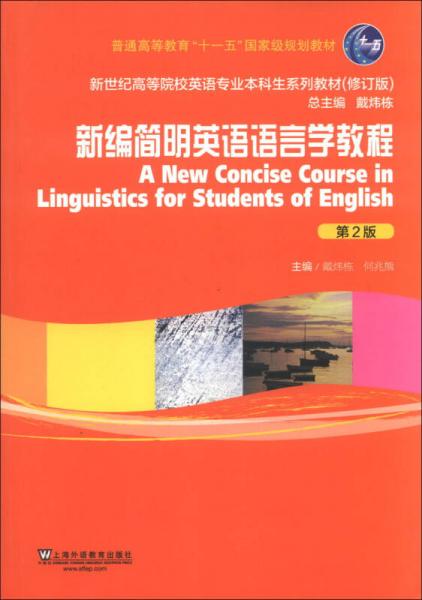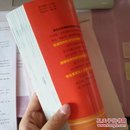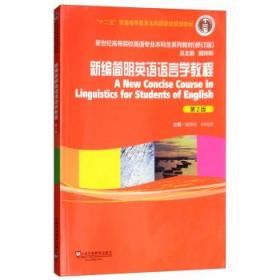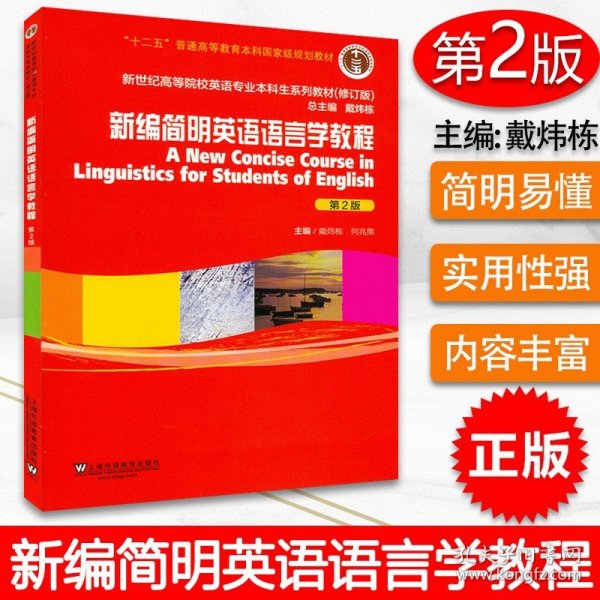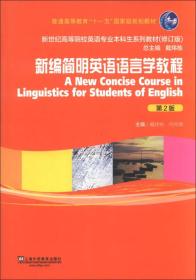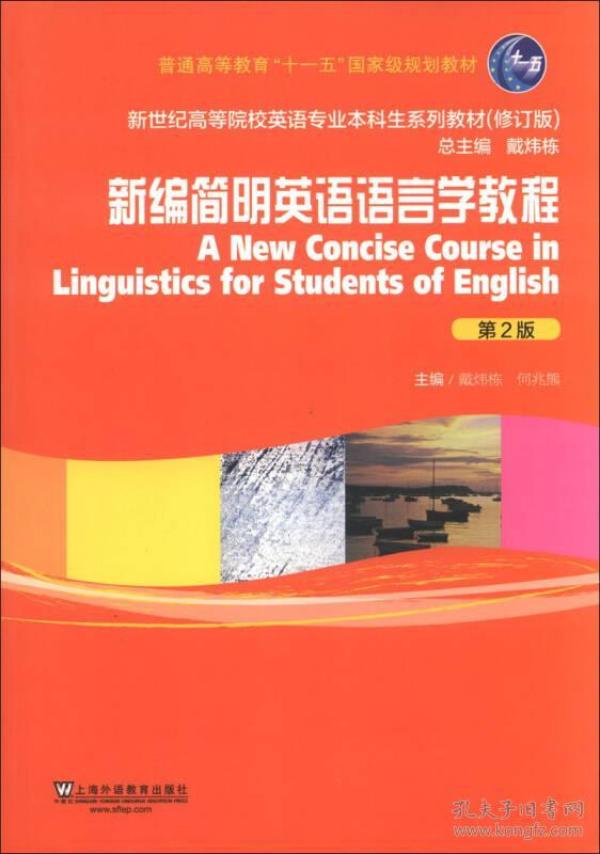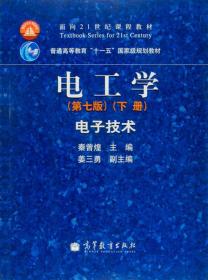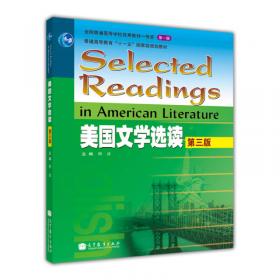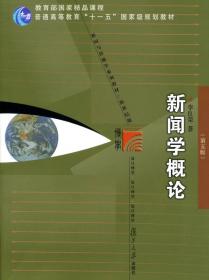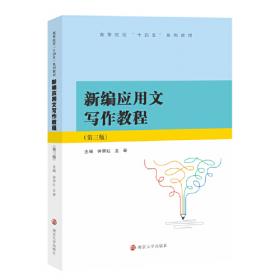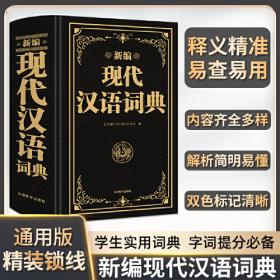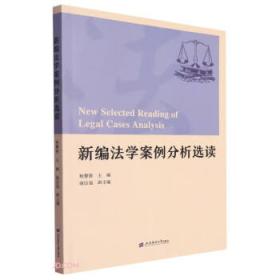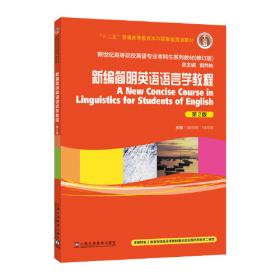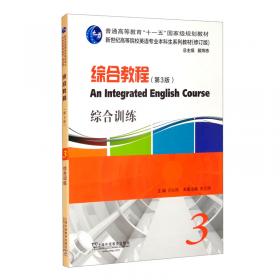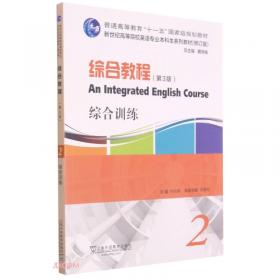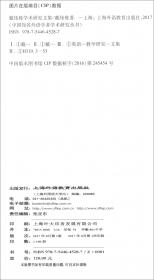新编简明英语语言学教程(第2版)
出版时间:
2013-05
版次:
2
ISBN:
9787544632713
定价:
24.00
装帧:
平装
开本:
16开
纸张:
胶版纸
页数:
199页
字数:
258千字
正文语种:
英语
1238人买过
-
《新世纪高等院校英语专业本科生教材(修订版):新编简明英语语言学教程(第2版)》特色:
权威性和先进性的体现:
按照《高等学校英语专业英语教学大纲》提出的培养目标、课程设置、教学要求和教学原则精心设计,凝聚海内外英语专业教育界专家学者的智慧,反映英语专业教育、科研的最新成果。
前瞻性和创新性的结晶
基于广泛的市场调研、详尽的需求分析和严谨的科学判断,梳理现有教程,优化教材结构,更新教学方法和手段,强化学生综合能力的培养。
专业素质和人文素养的同步提升
专业技能、专业知识、相关专业知识的完美匹配,帮助学生打下扎实的语言基本功,增强其分析问题、解决问题的能力,提高专业素质和人文素养,使学生真正成为国际化、创新型、高素质的英语专业人才。 Chapter 1 Introduction
1.1 What Is Linguistics?
1.1.1 Definition
1.1.2 The Scope Of Linguistics
1.1.3 Some Important Distinctions In Linguistics
1.2 What Is Language?
1.2.1 Definitions Of Language
1.2.2 Design Features Of Language
1.2.3 Functions Of Language
Revision Exercises
For Further Reading
Chapter 2 Phonology
2.1 The Phonic Medium Of Language
2.2 Phonetics
2.2.1 What Is Phonetics?
2.2.2 Organs Of Speech
2.2.3 Orthographic Representation Of Speech Sounds Broad And Narrow Transcriptions
2.2.4 Classification Of English Speech Sounds
2.3 Phonology
2.3.1 Phonology And Phonetics
2.3.2 Phone, Phoneme, And Allophone
2.3.3 Phonemic Contrast, Complementary Distribution,And Minimal Pair
2.3.4 Some Rules In Phonology
2.3.5 Suprasegmental Features —— Stress, Tone, Intonation
Revision Exercises
For Further Reading
Chapter 3 Morphology
3.1 Introduction
3.2 Open Class And Closed Class
3.3 Morphemes —— The Minimal Units Of Meaning
3.4 Analyzing Word Structures
3.5 Derivationa! Andinflectional Morphemes
3.6 Morphological Rules Of Word Formation
3.7 Derivation
3.8 Compounds
Revision Exercises
For Further Reading
Chapter 4 Syntax
4.1 What Is Syfitax?
4.2 Categories
4.2.1 Word-Level Categories
4.2.2 Phrase Categories And Their Structures
4.3 Phrase Structure Rule
4.3.1 Xprule
4.3.2 Coordination Rule
4.4 Phrase Elements
4.4.1 Specifiers
4.4.2 Complements
4.4.3 Modifiers
4.5 Sentences (The S Rule)
4.6 Transformations
4.6.1 Auxiliary Movement
4.6.2 Do Insertion
4.6.3 Deep Structure And Surface Structure
4.6.4 Wh Movement
4.6.5 Move A And Constraints On Transformations
Revision Exercises
For Further Reading
Chapter 5 Semantics
5.1 What Is Semantics?
5.2 Some Views Concerning The Study Of Meaning
5.2.1 The Naming Theory
5.2.2 The Conceptualist View
5.2.3 Contextualism
5.2.4 Behaviorism
5.3 Lexical Meaning
5.3.1 Senseand Reference
5.3.2 Major Sense Relations
5.4 Sense Relations Between Sentences
5.5 Analysis Of Meaning
5.5.1 Componential Analysis —— A Way To Analyze Lexical Meaning
5.5.2 Predication Analysis —— A Way To Analyze Sentence Meaning
Revision Exercises
For Further Reading
Chapter 6 Pragmatics
6.1 Som\\\'e Basic Notions
6.1.1 Definition
6.1.2 Pragmatics Vs.Semantics
6.1.3 Context
6.1.4 Sentence Meaning Vs.Utterance Meaning
6.2 Speech Act Theory
6.2.1 Austin\\\'s Model Of Speech Acts
6.2.2 Searle\\\'s Classification Of Speech Acts
6.2.3 Indirect Speech Acts
6.3 Principle Of Conversation
6.4 Cross-Cultural Pragmatic Failure
Revision Exercises
For Further Reading
Chapter 7 Language Change
7.1 Introduction
7.2 Phonological Changes
7.3 Morphological And Syntactic Change
7.3.1 Adclition Of Affixes
7.3.2 Loss Of Affixes
7.3.3 Change Of Word Order
7.3.4 Change In Negation Rule
7.4 Lexical\\\'and Semantic Change
7.4.1 Addition Of New Words
7.4.2 Loss Of Words
7.4.3 Semantic Changes
7.5 Some Recent Trends
7.5.1 Moving Towards Greater Informality
7.5.2 The Influence Of American English
7.5.3 The Influence Of Sci.Ence And Technology
7.6 The Causes Of Language Change
Revision Exercises
For Further Reading
Chapter 8 Language And Society
8.1 The Scope Of Sociolinguistics
8.1.1 The Relatedness Between Language And Society
8.1.2 Speech Community And Speech Variety
8.1.3 Two Approaches To Sociolinguistic Studies
8.2 Varieties Of Language
8.2.1 Dialectal Varieties
8.2.2 Register
8.2.3 Degree Of Formality
8.3 Standard Dialect
8.4 Pidgin And Creole
8.5 Bilingualism And Diglosia
Revision Exercises
For Further Reading
Chapter 9 Language And Culture
9.1 Introduction
9.2 What Is Culture?
9.3 The Relationship Between Language And Culture
9.4 Sapir-Whorf Hypothesis
9.5 Linguistic Evidence Of Cultural Differences
9.5, 1 Greetings And Terms Of Address
9.5.2 Gratitude And Compliments
9.5.3 Colour Words
9.5.4 Privacy And Taboos
9.5.5 Rounding Off Numbers
9.5.6 Words And Cultural-Specific Connotations
9.5.7 Cultural-Related Idioms, Proverbs And Metaphors
9.6 Culture Contact, Cultural Overlap And Diffusion
9.7 The Significance Of Cultural Teaching And Learning
9.8 Intercultural Communication
Revision Exercises
For Further Reading
Chapter 10 Language Acquisition
10.1 Introduction
10.2 Theories Of Child Language Acquisition
10.2.1 A Behaviourist View Of Language Acquisition
10.2.2 An Innatist View Of Language Acquisition
10.2.3 An Iriteractionist View Of Language Acquisition
10.3 Cognitive Development In Child Language Development
10.4 Language Environment And The Critical Period Hypo-Thesis
10.5 Stages In Child Language Development
10.5.1 Phonological Development
10.5.2 Vocabulary Development
10.5.3 Grammatical Development
10.5.4 Pragmatic Development
10.6 Atypical Development
Revision Exercises
For Further Reading
Chapter 11 Second Language Acquisition
11.1 Introduction
11.2 Connections Between First Language Acquisition And Second Language Acquisition
11.3 Contrastive Analysis
11.4 Error Analysis
11.5 Interlanguage
11.6 The Role Of The Native Language In Second Language Learning
11.7 Second Language Learning Models And Input Hypothesis
11.8 Individual Differences
11.9 Second Language Acquisition And Its Pedagogical Implications
Revision Exercises
For Further Reading
Chapter 12 Language And The Brain
12.1 Introduction
12.2 Neurolinguistics
12.2.1 What Is Neurolinguistics?
12.2.2 The Structure And Function Of The Human Brain
12.2.3 Methods For The Study Of The Brain And Evidences For Lateralization
12.2.4 Aphasia
12.3 Psycholinguistics
12.3.1 What Is Psycholinguistics?
12.3.2 Psycholinguistic Research Methods
12.3.3 Linguistics And Language Processing
12.3.4 Psycholinguistic Modeling
Revision Exercises
For Further Reading
A Glossary In English And Chinese
References
-
内容简介:
《新世纪高等院校英语专业本科生教材(修订版):新编简明英语语言学教程(第2版)》特色:
权威性和先进性的体现:
按照《高等学校英语专业英语教学大纲》提出的培养目标、课程设置、教学要求和教学原则精心设计,凝聚海内外英语专业教育界专家学者的智慧,反映英语专业教育、科研的最新成果。
前瞻性和创新性的结晶
基于广泛的市场调研、详尽的需求分析和严谨的科学判断,梳理现有教程,优化教材结构,更新教学方法和手段,强化学生综合能力的培养。
专业素质和人文素养的同步提升
专业技能、专业知识、相关专业知识的完美匹配,帮助学生打下扎实的语言基本功,增强其分析问题、解决问题的能力,提高专业素质和人文素养,使学生真正成为国际化、创新型、高素质的英语专业人才。
-
目录:
Chapter 1 Introduction
1.1 What Is Linguistics?
1.1.1 Definition
1.1.2 The Scope Of Linguistics
1.1.3 Some Important Distinctions In Linguistics
1.2 What Is Language?
1.2.1 Definitions Of Language
1.2.2 Design Features Of Language
1.2.3 Functions Of Language
Revision Exercises
For Further Reading
Chapter 2 Phonology
2.1 The Phonic Medium Of Language
2.2 Phonetics
2.2.1 What Is Phonetics?
2.2.2 Organs Of Speech
2.2.3 Orthographic Representation Of Speech Sounds Broad And Narrow Transcriptions
2.2.4 Classification Of English Speech Sounds
2.3 Phonology
2.3.1 Phonology And Phonetics
2.3.2 Phone, Phoneme, And Allophone
2.3.3 Phonemic Contrast, Complementary Distribution,And Minimal Pair
2.3.4 Some Rules In Phonology
2.3.5 Suprasegmental Features —— Stress, Tone, Intonation
Revision Exercises
For Further Reading
Chapter 3 Morphology
3.1 Introduction
3.2 Open Class And Closed Class
3.3 Morphemes —— The Minimal Units Of Meaning
3.4 Analyzing Word Structures
3.5 Derivationa! Andinflectional Morphemes
3.6 Morphological Rules Of Word Formation
3.7 Derivation
3.8 Compounds
Revision Exercises
For Further Reading
Chapter 4 Syntax
4.1 What Is Syfitax?
4.2 Categories
4.2.1 Word-Level Categories
4.2.2 Phrase Categories And Their Structures
4.3 Phrase Structure Rule
4.3.1 Xprule
4.3.2 Coordination Rule
4.4 Phrase Elements
4.4.1 Specifiers
4.4.2 Complements
4.4.3 Modifiers
4.5 Sentences (The S Rule)
4.6 Transformations
4.6.1 Auxiliary Movement
4.6.2 Do Insertion
4.6.3 Deep Structure And Surface Structure
4.6.4 Wh Movement
4.6.5 Move A And Constraints On Transformations
Revision Exercises
For Further Reading
Chapter 5 Semantics
5.1 What Is Semantics?
5.2 Some Views Concerning The Study Of Meaning
5.2.1 The Naming Theory
5.2.2 The Conceptualist View
5.2.3 Contextualism
5.2.4 Behaviorism
5.3 Lexical Meaning
5.3.1 Senseand Reference
5.3.2 Major Sense Relations
5.4 Sense Relations Between Sentences
5.5 Analysis Of Meaning
5.5.1 Componential Analysis —— A Way To Analyze Lexical Meaning
5.5.2 Predication Analysis —— A Way To Analyze Sentence Meaning
Revision Exercises
For Further Reading
Chapter 6 Pragmatics
6.1 Som\\\'e Basic Notions
6.1.1 Definition
6.1.2 Pragmatics Vs.Semantics
6.1.3 Context
6.1.4 Sentence Meaning Vs.Utterance Meaning
6.2 Speech Act Theory
6.2.1 Austin\\\'s Model Of Speech Acts
6.2.2 Searle\\\'s Classification Of Speech Acts
6.2.3 Indirect Speech Acts
6.3 Principle Of Conversation
6.4 Cross-Cultural Pragmatic Failure
Revision Exercises
For Further Reading
Chapter 7 Language Change
7.1 Introduction
7.2 Phonological Changes
7.3 Morphological And Syntactic Change
7.3.1 Adclition Of Affixes
7.3.2 Loss Of Affixes
7.3.3 Change Of Word Order
7.3.4 Change In Negation Rule
7.4 Lexical\\\'and Semantic Change
7.4.1 Addition Of New Words
7.4.2 Loss Of Words
7.4.3 Semantic Changes
7.5 Some Recent Trends
7.5.1 Moving Towards Greater Informality
7.5.2 The Influence Of American English
7.5.3 The Influence Of Sci.Ence And Technology
7.6 The Causes Of Language Change
Revision Exercises
For Further Reading
Chapter 8 Language And Society
8.1 The Scope Of Sociolinguistics
8.1.1 The Relatedness Between Language And Society
8.1.2 Speech Community And Speech Variety
8.1.3 Two Approaches To Sociolinguistic Studies
8.2 Varieties Of Language
8.2.1 Dialectal Varieties
8.2.2 Register
8.2.3 Degree Of Formality
8.3 Standard Dialect
8.4 Pidgin And Creole
8.5 Bilingualism And Diglosia
Revision Exercises
For Further Reading
Chapter 9 Language And Culture
9.1 Introduction
9.2 What Is Culture?
9.3 The Relationship Between Language And Culture
9.4 Sapir-Whorf Hypothesis
9.5 Linguistic Evidence Of Cultural Differences
9.5, 1 Greetings And Terms Of Address
9.5.2 Gratitude And Compliments
9.5.3 Colour Words
9.5.4 Privacy And Taboos
9.5.5 Rounding Off Numbers
9.5.6 Words And Cultural-Specific Connotations
9.5.7 Cultural-Related Idioms, Proverbs And Metaphors
9.6 Culture Contact, Cultural Overlap And Diffusion
9.7 The Significance Of Cultural Teaching And Learning
9.8 Intercultural Communication
Revision Exercises
For Further Reading
Chapter 10 Language Acquisition
10.1 Introduction
10.2 Theories Of Child Language Acquisition
10.2.1 A Behaviourist View Of Language Acquisition
10.2.2 An Innatist View Of Language Acquisition
10.2.3 An Iriteractionist View Of Language Acquisition
10.3 Cognitive Development In Child Language Development
10.4 Language Environment And The Critical Period Hypo-Thesis
10.5 Stages In Child Language Development
10.5.1 Phonological Development
10.5.2 Vocabulary Development
10.5.3 Grammatical Development
10.5.4 Pragmatic Development
10.6 Atypical Development
Revision Exercises
For Further Reading
Chapter 11 Second Language Acquisition
11.1 Introduction
11.2 Connections Between First Language Acquisition And Second Language Acquisition
11.3 Contrastive Analysis
11.4 Error Analysis
11.5 Interlanguage
11.6 The Role Of The Native Language In Second Language Learning
11.7 Second Language Learning Models And Input Hypothesis
11.8 Individual Differences
11.9 Second Language Acquisition And Its Pedagogical Implications
Revision Exercises
For Further Reading
Chapter 12 Language And The Brain
12.1 Introduction
12.2 Neurolinguistics
12.2.1 What Is Neurolinguistics?
12.2.2 The Structure And Function Of The Human Brain
12.2.3 Methods For The Study Of The Brain And Evidences For Lateralization
12.2.4 Aphasia
12.3 Psycholinguistics
12.3.1 What Is Psycholinguistics?
12.3.2 Psycholinguistic Research Methods
12.3.3 Linguistics And Language Processing
12.3.4 Psycholinguistic Modeling
Revision Exercises
For Further Reading
A Glossary In English And Chinese
References
查看详情
-
全新
-
全新
北京市海淀区
平均发货28小时
成功完成率82.22%
-
全新
江苏省南京市
平均发货44小时
成功完成率76.09%
-
全新
江苏省南京市
平均发货22小时
成功完成率70.74%
-
全新
-
全新

 占位居中
占位居中

